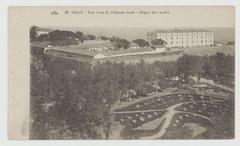
Abdallah Ibn Salam Mosque Visiting Hours, Tickets, and Historical Significance in Oran, Algeria
Date: 03/07/2025
Introduction
Nestled in the heart of Oran, Algeria, the Abdallah Ibn Salam Mosque is a living monument to the city’s layered religious and cultural history. Originally constructed as the Great Synagogue of Oran during the late 19th and early 20th centuries, this remarkable structure stands as a testament to Oran’s vibrant Jewish community of the past. Its transformation into a mosque in the 1970s, after the Jewish population’s departure post-independence, reflects the profound changes experienced by the city and its people.
Named after Abdallah Ibn Salam—a 7th-century Jewish rabbi who became a companion of Prophet Muhammad—the mosque embodies themes of interfaith dialogue, cultural coexistence, and historical continuity. Today, it draws visitors from around the world who are keen to explore its unique blend of Neo-Mudéjar, Moorish Revival, and Jewish architectural elements, as well as its significance within Oran’s spiritual landscape.
This guide offers a comprehensive overview of the Abdallah Ibn Salam Mosque, including its historical evolution, architectural features, visiting hours, ticketing information, accessibility, and practical travel tips. Whether you are a history enthusiast, architecture lover, or a curious traveler, this resource will enrich your experience when visiting this extraordinary site in Oran.
For further historical context and visitor information, see Wikipedia, The Times of Israel, and ArchNet.
Historical Background and Transformation
From Synagogue to Mosque
The building now known as the Abdallah Ibn Salam Mosque was originally constructed as the Great Synagogue of Oran (Grande Synagogue d’Oran). Construction began in 1880, spearheaded by Simon Kanoui, and was completed in 1918 (Wikipedia). The synagogue, once among North Africa’s largest, stood as a focal point for Oran’s flourishing Jewish community, accommodating up to 2,000 worshippers and serving as a center for worship, education, and cultural gatherings.
However, Algeria’s war of independence (1954–1962) and the subsequent exodus of the Jewish population to France led to the synagogue’s closure. In 1972, the building was converted—along with other former synagogues across Algeria—into a mosque, and renamed Abdallah Ibn Salam Mosque (The Leisure Society). The transformation retained much of the original architectural character while integrating Islamic features such as the mihrab and minbar, making it a rare example of religious and architectural adaptation (ArchNet).
Symbolic Namesake
Abdallah Ibn Salam, originally Al-Husayn ibn Salam, was a noted Jewish rabbi in Medina who converted to Islam during Prophet Muhammad’s era. He is celebrated in both Islamic and interfaith traditions as a symbol of religious respect and coexistence (Wikipedia). Naming the mosque after him encapsulates the spirit of mutual understanding and shared heritage that defines this historic site.
Architectural Features and Styles
Exterior
The mosque’s striking façade is characterized by two symmetrical towers—originally part of the synagogue—now serving as minarets. These towers reach approximately 20 meters in height and are topped with domes, creating a harmonious silhouette against Oran’s skyline. The rose-colored stained glass windows and three grand portals, adorned with geometric Moorish motifs and intricately carved stonework, highlight the building’s blend of Jewish and Islamic influences. Elements such as Jerusalem stone and horseshoe arches reflect the synagogue’s origins while seamlessly integrating with Islamic design.
The mosque is set within a spacious, paved courtyard, providing a tranquil respite from the city and offering ample space for large congregations during religious events.
Interior
Inside, the vast nave is supported by robust red marble columns with ornate capitals, separating the central prayer hall from side aisles. The arches display intricate arabesques, typical of Moorish Revival architecture, while the spatial layout—largely preserved from its synagogue days—creates an atmosphere of grandeur and openness.
Colored stained glass in the entry portals bathes the prayer hall in vibrant light, enhancing its serene ambiance. The mosque’s walls are adorned with flowing Arabic calligraphy and decorative tilework in blues, greens, and golds. The focus of religious activity is the beautifully crafted mihrab and adjacent minbar, both harmonizing with the structure’s overall design.
Styles and Materials
The Abdallah Ibn Salam Mosque exemplifies Neo-Mudéjar and Moorish Revival styles, with design inspiration from medieval Spanish Mudéjar architecture and European Orientalism. Materials such as Jerusalem stone, red marble, and stained glass exemplify the building’s Mediterranean, Spanish, and Levantine influences, contributing to its durability and artistic richness (ArchNet).
Visiting Abdallah Ibn Salam Mosque: Hours, Tickets & Accessibility
Visiting Hours
The mosque is generally open to visitors daily from 8:00 AM to 6:00 PM. However, access may be restricted during Islamic prayer times, particularly during Friday midday (Jumu’ah) and religious holidays. It is always advisable to check with local tourism offices or the mosque directly for up-to-date information.
Tickets and Admission
Entry is free of charge. As the mosque functions primarily as a place of worship, visitors are welcome to admire its architecture and history respectfully. Voluntary donations are appreciated and help support the mosque’s maintenance and community activities.
Accessibility
The mosque is accessible to individuals with mobility impairments, featuring ramps and accessible entrances. Facilities such as restrooms and ablution (wudu) areas are available, though dedicated visitor centers are limited. For specific accessibility needs, contacting the mosque or tourism authorities in advance is recommended.
Dress Code and Visitor Etiquette
- Men: Wear long trousers and sleeved shirts; shorts and sleeveless tops should be avoided.
- Women: Wear loose-fitting clothing covering arms and legs; a headscarf is recommended.
- Footwear: Remove shoes before entering the prayer hall and leave them in designated racks.
- General: Maintain a quiet demeanor, refrain from loud conversation or phone use, and greet others politely (Blue Mosque Dress Code Guide).
Photography may be permitted in exterior areas, but always ask permission before photographing the interior or worshippers.
Visitor Tips
- The best times to visit are mid-morning or late afternoon, outside peak prayer times.
- Guided tours are available through local tourism agencies and offer deeper insights into the mosque’s history and architecture.
- Bring water and wear comfortable shoes, especially if exploring the surrounding district.
Location, Directions, and Nearby Attractions
Centrally located on Boulevard Abderahmane Mira, the mosque is easily accessible via taxi, public transport, or on foot from Oran’s main attractions. As a starting point for exploring Oran’s historical sites, it is close to:
- Santa Cruz Fortress: Panoramic views over Oran and its bay.
- Place du 1er Novembre: The city’s main square, surrounded by colonial-era architecture.
- Cathédrale du Sacré-Cœur: Now a public library, notable for its architectural style.
- Oran’s Old Town (La Ville Nouvelle): Markets, cafés, and historic buildings.
Numerous cafés and shops nearby offer opportunities to experience local cuisine and culture.
Religious Practices and Community Life
The mosque is an active center for daily prayers, Friday congregational prayer, and significant Islamic festivals such as Ramadan and Eid. It also hosts charitable, educational, and community programs, maintaining its role as a vital part of Oran’s religious and social fabric (El Watan).
Interfaith and Cultural Dialogue
As a former synagogue turned mosque, the Abdallah Ibn Salam Mosque is frequently cited as a symbol of religious coexistence and mutual respect. It plays a role in interfaith events and cultural initiatives, promoting dialogue and understanding within Oran’s diverse society (Middle East Eye).
Preservation and Heritage
Conservation efforts focus on maintaining the mosque’s unique architectural blend. While the transformation from synagogue to mosque is sometimes debated in heritage circles, the building remains a protected site and an emblem of Oran’s multifaceted history (UNESCO).
Frequently Asked Questions (FAQ)
Q: What are the mosque’s visiting hours?
A: Daily from 8:00 AM to 6:00 PM; access may be limited during prayers.
Q: Is there an entrance fee?
A: No, entry is free; donations are welcome.
Q: Are non-Muslims allowed to visit?
A: Yes, non-Muslim visitors are welcome outside prayer times, but should dress modestly and respect mosque etiquette.
Q: Are guided tours available?
A: Yes, local guides and agencies offer tours covering the mosque and other Oran historical sites.
Q: Can I take photographs inside?
A: Photography may be restricted inside; always ask permission first.
Q: Is the mosque accessible for people with disabilities?
A: There are ramps and accessible entrances; contact the mosque for specific needs.
Conclusion and Visitor Recommendations
The Abdallah Ibn Salam Mosque is not merely a place of worship; it is a living symbol of Oran’s rich, multicultural past. Its architectural beauty and historical resonance make it a must-visit site for anyone interested in Algeria’s heritage. Visitors are encouraged to respect the mosque’s religious significance, dress appropriately, and visit outside peak prayer times to fully appreciate its serene ambiance.
The mosque’s central location offers an ideal gateway to explore Oran’s other treasures, such as the Santa Cruz Fortress and Sacré-Cœur Cathedral. For a deeper understanding, consider joining a guided tour and consult official tourism resources for the latest updates.
For more information, visit Safarway, The Leisure Society, and Algeria.com.
Plan Your Visit
Download the Audiala app for audio tours, detailed maps, and visitor updates. Follow us on social media for travel tips and inspiration.
Sources and Further Reading
- Grande Synagogue d’Oran, Wikipedia, 2024
- In Algeria, a Grand Synagogue Becomes a Mosque, The Times of Israel, 2021
- Abdallah Ibn Salam Mosque, Algeria.com, 2023
- Abdallah Ibn Salam Mosque, ArchNet, 2024
- Must-See Places in Oran, The Leisure Society, 2023
- La Grande Synagogue d’Oran, Safarway, 2024
- Blue Mosque Dress Code Guide
- El Watan
- Middle East Eye
- UNESCO



